Delhi: G
This is a collection of articles archived for the excellence of their content. |
Contents[hide] |
Gali Paranthe Wali
For Paranthe Wali Gali see Delhi: P
Gandhi Nagar
Notorious Market
Paras Singh, Jan 01 2017: The Times of India

A Dolce & Gabbana leather jacket! Not quite sitting in comfort among baby suits and gaudy women's wear, but then there is that distinctive logo sewn into the lapel: D&G. It also has paper labels imprinted with the logo, apparel details and the price: Rs 300! A quick glance at the ware in the shops lining the street confirms the revered brand is in great company with Zara and Giorgio Armani, Lacoste and Paul Smith. Also quietly peeping out from among the array are jeans with their “G&G“ logo gamely trying to mimic the venerated “D&G“.
Everything here costs a minute fraction of the real prices. That is why these streets of Gandhi Nagar in east Delhi figure in the list of `Notorious Markets' released annually by the Department of United States Trade Representative. The sanctity of brand names and trademarks has no meaning here. Reebok, Adidas and Nike are names that have been so routinely duplicated in Gandhi Nagar that they are disdained by buyers. Armani and D&G are the flavours of the season.
Located along the road skirting the Yamuna, this maze of colourful, crowded lanes is a haven for shoppers -and a hell for multinational brands. Although the market sells replicas of global design houses sourced from Kolkata, Ludhiana and China for prices ranging from Rs 50 to Rs 300, most of the products are manufactured in tiny units in the Trans-Yamuna areas of Dharampura, Kailash Nagar, Seelampur, Ajeet Nagar and Raghubar Pura. It is from Gandhi Nagar that the fake brands make their way to markets across the country .
Gandhi Nagar has come a long way since 1970, when it comprised a few outlets in Ashok Gali. Today it has over 10,000 stalls, and half a million people depend on the market for their livelihood. No wonder the shop owners are so touchy when the issue of intellectual property rights props up. “Yes, every one is honest, from police and income tax officials to government babus, everyone except the traders,“ huffs trader Purushottam Sharma. “Gandhi Nagar provides quality clothes to cover the bodies of India's teeming poor,“ he adds to clinch his argument.
Another trader argues, “What companies call counterfeit, we define it as local ingenuity for survival.“ This semantic absolution explains the proliferation of jackets, sweatshirts, jeans and shirts bearing the logos of Armani, Polo, Zara, Lacoste, Levis, Pepe, D&G and of Apple, Mercedes-Benz and Ferrari. Given this, Deshraj Malhotra, president of the Association of Whole Readymade Garment Market, is clearly being disingenuous when he says, “The issue of fakes is a ploy to defame us.“
But Gandhi Nagar's appearance in the Notorious Markets list means that the world has taken note of the wanton violation of IPR by traders here and in markets like Baiyun in Shanghai, Ikeja in Lagos and La Salada in Buenos Aires. The USTR expects the operators and the government to deal with the menace. When told this, Hukum Chand Gupta, president of the Gandhi Nagar Trad ers Association, mellows a little and admits, “Yes, some traders are forced to sell fakes to earn a bit, but it is not rampant here.“
The shop owners will not be overly worried, though. Officers at the Gandhi Nagar police station told TOI that they are “yet to receive any complaint about counterfeiting of their products in the market from any company“. Besides, the USTR report notes that the Indian government enforced no meaningful, effective measures after the earlier listing of Nehru Place, Gaffar Market, Tank Road and Sadar Bazar in the Notorious Markets list.
Garhi (artists’ village)
2019: collapse of Jharia Maria
Mohammad Ibrar, July 19, 2019: The Times of India
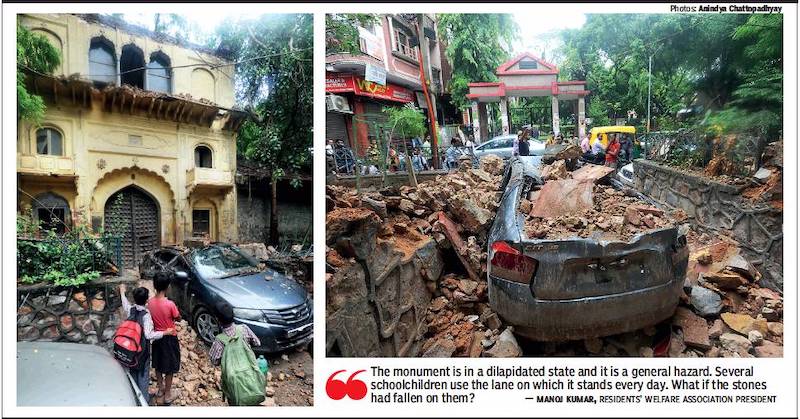
From: Mohammad Ibrar, July 19, 2019: The Times of India
Garhi village in south Delhi’s East of Kailash woke up to discover that the upper portion of an 18th century structure there had crashed down on to the car of a resident. The gateway, locally called Jharia Maria and claimed to be of Rajput provenance, is visibly dilapidated, and the residents grumbled that despite the dangers it posed, the civic authorities had never heeded their requests for its conservation.
The unfortunate owner of the crushed car, garments businessman Raju Chowdhary, said that he usually parked his Honda City at the gate, which leads to a DDA park where the Garhi artists’ studio of Lalit Kala Akademi is located. “I never expected the rain to bring the structure crumbling down and leave my car in this state,” said an agitated Chowdhary.
Manoj Kumar, residents’ welfare association president, claimed that the residents had filed numerous complaints about the derelict condition of the structure to the civic authorities. “The monument is in a dilapidated state and it is a general hazard. Several schoolchildren use the lane on which it stands every day. What if the stones had fallen on them?” he fretted.
The villagers of Garhi are quite upset. “The chaupal is a part of our heritage. The villagers come here for puja and to celebrate the foundation day of this chaupal every year on April 17,” said Ajit. A board inside the park says that the chaupal was established in 1742 by a certain Chowdhary Gulab Singh Gujjar.
While DDA has put up signboard outside the gate, an official of the agency’s horticulture department claimed that it belonged to the Lalit Kala Akademi. Abhishek, who did not give his surname, is an artist at the Garhi Artists’ Studio. He claimed that Akademi officials had written to the Archaeological Survey of India as well as Delhi government’s archaeology department about maintaining the aged structure. “But we never got any responses to our requests,” he said.
According to the Indian National Trust for Art and Cultural Heritage, the complex is an unprotected monument that is not maintained by ASI. D C Sharma of ASI’s Delhi circle confirmed this. “This monument is not on our list of monuments. It must be under some other agency,” he said. An official of DDA’s architecture department, who requested anonymity, finally admitted that “it is under our jurisdiction and we have been intending to restore it”.
Historians are aghast at the incident. “Heritage gives us a peep into our past, but we are so careless about it,” rued archaeologist Shivam Dubey. “It is painful to see the Jharia Maria falling down. It has a historical significance, and the agency responsible should have taken care to restore and preserve it.”
Ghantewala sweets, Chandni Chauk
The Times of India, Jul 02 2015
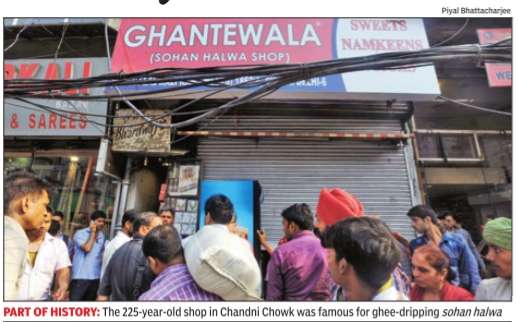
Avijit Ghosh & Richi Verma
ICONIC SHOP - Dwindling business rings down curtain on city's oldest mithai shop
When Ghantewala opened in 1790, Mughal emperor Shah Alam II ruled Delhi, Tipu Sultan was firmly in the saddle in Mysore and Paris still consumed by the French Revolution. The 225-year-old iconic sweet shop in Old Delhi's Chandni Chowk downed its shutters. A delectable chapter in the capital's culinary history is over. “It is difficult for me to talk about the shop right now.Please remember we owned it for eight generations. The thing is: falling sales made it an unprofitable venture for us,“ owner Sushant Jain told TOI over phone.
Ghantewala's ghee-dripping sohan halwa spawned serious fandom in the pre-cholesterol-obsessed era. “Rajiv Gandhi came here. I remember Mohd Rafi who arrived in a car. Even Morarji Desai used to get jalebis specially packed from this place. During Diwali, the shop owners would summon police to maintain order and manage the customers who would queue restlessly for mithais,“ recalled Ashok Arora, who owns Anarkali Bazar, an adjacent sari shop.
“The shop was a magnet for tourists. Dozens of foreigners would clutch at their travel guides and take selfies before the shop. Even now, when anybody asks for directions to my shop, I always say , next to Ghantewala. For me, it's a day of mourning,“ said Arora.
There are different versions how the shop got its name. It is said that the sweet shop was named after a clock tower located nearby . Another version is that the shop got its name from a school bell (ghanta). Apparently the Mughal emperor, who could hear the bell toll from his Red Fort residence, would ask for sweets from the shop located near the ghanta; hence the name.
Historians termed the closure of Ghantewala sweet shop as a huge loss to traditional Old Delhi. “It was probably the oldest and the most famous shop in the area. People associate their memories of Chandni Chowk with Ghantewala in the same way that one links Karim's to Jama Masjid. It was part of Shahjahanabad's intangible heritage,“ said A G K Menon, convener, INTACH Delhi Chapter.
There were two ghantewala shops in Chandni Chowk.The one closer to the Chandni Chowk's fountain, Ghante Wala Shahi halwai, had closed several years ago. The second one, located on the other side of the road, remained in business. There's even a lane named after it, Ghantewali gali. According to residents, the shop was divided between two brothers almost two decades ago. While the elder brother sold his share several years ago, the other portion was operated by Sushant.
Locals said business started dwindling over the last decade or so. As other shops expanded and new ones opened up, Ghantewala was barely able to cope, said a local trader.
The sweet shop finds mention in Mahmood Farooqui's book, Besieged. Quoting contemporary newspaper, Dehli Urdu Akhbar, it says, “The troops who can act with great daring outside...the moment they go around Jama Masjid and enjoy the qalaqaand of Ghantewala and its laddus, they lose all urge and determination to fight.“
The 1954 Hindi film, Chandni Chowk, starring Meena Kumari, also included scenes filmed before the famous sweet shop.
Ghazipur
Hill-sized landfill
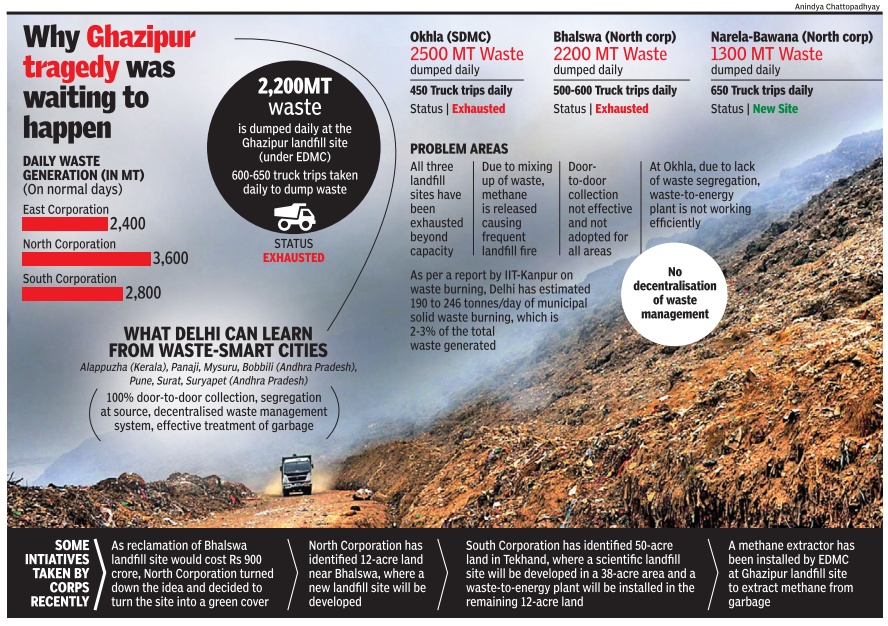
The Ghazipur landfill reached its exhaustion level in 2002, but for a decade and a half, garbage continued to be dumped there. Having crossed the permitted height of 20 metres and reached 50, it was perhaps a matter of time before the mountain of muck toppled over, as it did on Friday . However, with a sense of complacency , and perhaps a bit of frustration at the lack of available space in a land-starved city , the municipal corporations have continued piling waste in their overused landfills.
Ranbir Singh, commissioner of East Delhi Municipal Corporation, which owns the Ghazipur landfill, said on Friday that he would try to find an alternative site in consultation with other government agencies. Senior civic officials even claimed to have requested Delhi Development Authority numerous times for plots to use as landfills. But it took two deaths to bring the dangers home to them. And while East Delhi MP Mahesh Girri may proclaim, “I have spoken to lieutenant governor Anil Baijal about shifting the landfill site and requested compensation for those who died“, it still does not explain the lack of urgency in trying to find new places for, or better ways of waste disposal.
One of the problems with waste management in Delhi is the failure of the municipal corporations to move away from traditional waste disposal methods. While smaller cities such as Suryapet (Andhra Pradesh), Mysuru (Karnataka), Surat (Gujarat), Panaji (Goa) and Pune (Maharashtra) have successfully managed to adopt a more efficient, modern waste management system with segregation of garbage at source and decentralisation of waste management, the capital's civic bodies have failed even to initiate the process of separating garbage into dry waste, recyclables and organic matter or to set up 100% door-to-door collection of municipal waste.
Because of this, landfills choke up quickly . Lately, the south corporation was allotted a 50-acre expanse in Tekhand, where it plans to develop a scientific landfill along with installation of waste-toenergy and composting plants. Puneet Goel, commissioner, SDMC, that in creating the landfill, the civic body will follow the norms under the new Municipal Solid Waste Rules. “The waste will take up 38 acres, and we will install waste-to-energy and composting plants in the remaining 12 acres,“ he said. “And once this landfill is developed, we will reclaim the Okhla site.“
The reclamation plan for the smouldering landfill at Bhalswa was rejected as too costly at Rs 900 crore by the cash-strapped north corporation.
Commissioner PK Gupta said, “This is way too much given our financial status, but we have decided to turn the site into a green area by extracting methane and covering the mountain of garbage with soil.“
Gupta added that the corporation had planned to give the garbage from Bhalswa to the National Highways Authority of India for use in road construction, but a study established that Bhalswa's waste had zero calorific value and was no good for such uses.
“We could not stop dumping trash at Bhalswa altogether,“ the commissioner explained, and added that they now have an option with DDA having given the corporation a 12-acre space. “We will install a waste-to-energy plant in advance to ensure recycling,“ he promised. “We have also asked for an 8-acre land near Azadpur Mandi, where we will install a composting unit to process biodegradable material.“
Slaughterhouse
Paras Singh, City slaughterhouse takes green steps, March 5, 2018: The Times of India
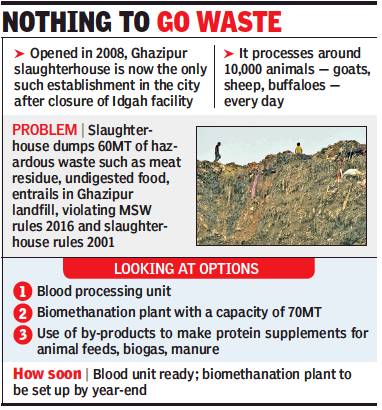
From: Paras Singh, City slaughterhouse takes green steps, March 5, 2018: The Times of India
To Rid Ghazipur Landfill Of Polluting Waste
With the east corporation trying to reduce the pollution footprint of the city’s only functional slaughterhouse, the Ghazipur landfill site and its surrounding areas are likely to get respite from one of the most polluting forms of waste.
The Ghazipur slaughterhouse, which processes over 5,000 livestocks in a four-hour batch, has been a constant source of pollution and unbearable stench for its surrounding areas. Flouting both municipal solid waste rules 2016 and slaughterhouse rules 2001, it dumps around 60-70 tonnes of such waste — blood, entrails and undigested food — in the Ghazipur open landfill site every day.
After repeated raps by Delhi Pollution Control Committee (DPCC), commissioner Ranbir Singh has announced modernisation plans to tackle the waste generated during the slaughtering by setting up facilities like a blood processing unit and a biomethanation plant, and redeveloping the adjacent livestock market.
The blood released during the slaughtering process will now be collected and scientifically processed instead of releasing it into the drain, said Dr Hari Lal, the corporation’s former director of veterinary services and currently its consultant. “As final products, it will be converted into protein supplements and used in animal feeds in poultry and fish industries.”
The blood processing plant, which is almost ready, will have a capacity of 20,000 litres of blood per batch. The plant, set up by slaughterhouse operator Messrs Allana, is undergoing trial runs.
Two large underground water tanks are also being constructed to store the effluent water. “Around 2,000KLD effluent from the complex is treated. While the treated water can be used in irrigation and washing, the rest will be stored in the tanks,” Dr Lal said.
The corporation has also finalised plans to build a biomethanation plant to process the undigested food that comes out of the stomach of buffaloes, sheep and goats. Spread over 0.9 acres, the plant will cost over Rs 10.15 crore. Tenders have already been awarded .
“We will use this to produce biomethane gas that will be filtered and converted into green energy,” Dr Lal said. “Its maximum capacity will be 70 metric tonnes but we have estimated that even at the current rate, we will get an assured supply of 35 metric tonnes.” Around 50-60 tonnes of undigested food is daily dumped in the landfill site.
Geeta Colony
Wasteland converted into forest
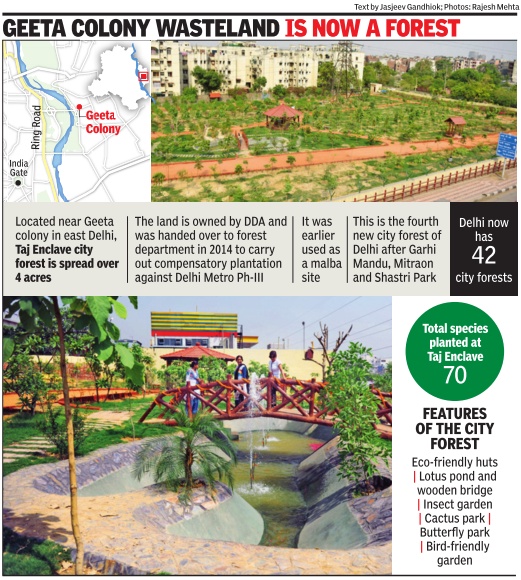
See graphic.
Wasteland management in Geeta Colony, New Delhi
Gole Market
History

From: Atul Mathur & Vibha Sharma TNN, June 30, 2023: The Times of India
See graphic:
A brief history of Delhi’s Gole Market, as in 2023
Katra Gokulshah
2019: Marham’s initiative
Paras Singh, Youths spark ‘clean’ change in old city, January 22, 2019: The Times of India
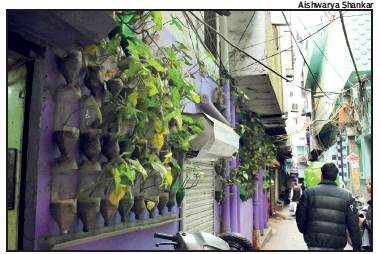
From: Paras Singh, Youths spark ‘clean’ change in old city, January 22, 2019: The Times of India
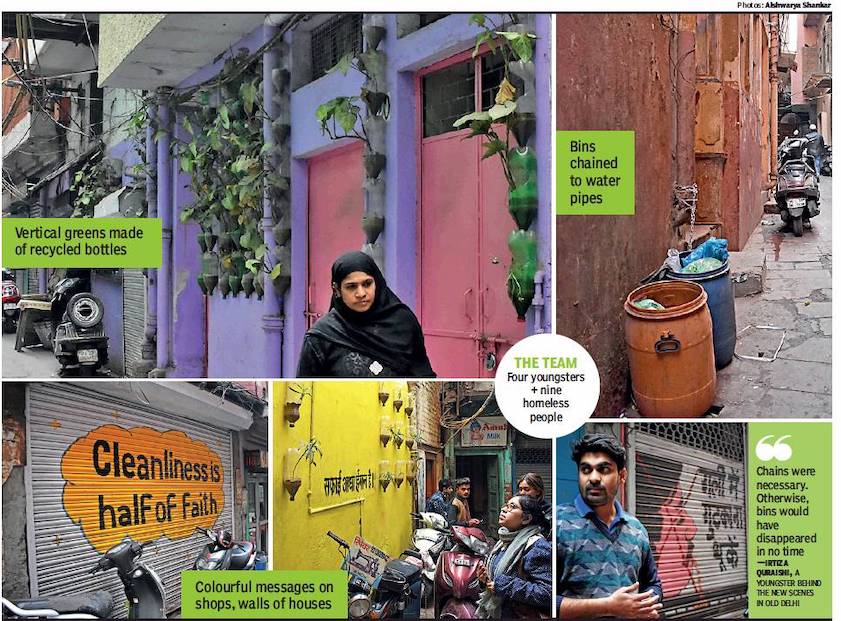
From: Paras Singh, Youths spark ‘clean’ change in old city, January 22, 2019: The Times of India
Katra Gokulshah was like many other narrow kuchas of Old Delhi that assailed the senses with their garbage heaps, walls stained with betel juice and a nauseating odour hanging heavy in the air. Today, the lane has a freshness to it. The walls are adorned with vertical gardens and there are blue-green trash bins in every nook and corner.
“You don’t need to cover your nose while passing by our locality. There’s a world of a difference between then and now,” preens Mohsin Mirza, a shopkeeper on the lane.
This miracle of sorts was achieved not through government effort, but the vision of a group of young professionals. Their initial aim was to adopt the homeless in the area. The project took an inspired turn when the youths started inspiring and training the adopted people to take up the challenge of keeping these historical quarters of the capital, near Bazar Sita Ram, clean.
Safai aadha iman hai (Cleanliness is half your faith), read the words on the daffodil yellow wall in Pahari Imli area, encapsulating the belief of Marham, the youth collective behind the clean-up.
Marham’s four young members — Irtiza Quraishi, Waqar Ahmed, Anam Hasan and Sadia Syed — operate from a library in Pahari Imli, and are helped in their project by the nine homeless people they adopted two years ago.
Writing on the wall: Together, we can
Homeless Help Youths Keep Locality Free Of Filth
When we proposed the idea of training our adopted people in composting, gardening, calligraphy and managing the cleanliness of old Delhi nine months ago, everyone thought we were mad,” recalled Quraishi. But Katra Gokulshah, the first zone taken up, proved that it could be done, and the collective is now into its second project.
The quartet, young as they are, (in their 20s and 30s) are wise about the ways of the world. Founder Quraishi worked with American Express till 2012, Syed is a theatre activist, Ahmed runs a business in tools and Hasan works with the Rajiv Gandhi Foundation. Quickly realising that arguments about environmental damage didn’t find takers in these old quarters, they cleverly started conversations around “people refusing to marry off their sons to daughters living on a filthy lane” or “property rates will go up once the area is cleared of muck”.
Effort like this has led to the shop shutters along Katra Gokulshah bearing colourful messages and pictures exhorting people to pay attention to public hygiene. The walls are covered with plants growing in discarded cola bottles. At one point there two bins chained to the water pipes. “Chains were necessary to keep the bins from disappearing,” chuckled Quraishi. After five months of watching educational videos, drawing up plans and winning over doubters, the journey started with the screening of a Satyamev Jayate episode on cleanliness attended by the 12 residents’ welfare associations of the area.
Marham insists on financial contribution from the residents so that they feel they are stakeholders in the process.
“Once a lane is identified, we determine where the garbage collection spots and their source houses can be. Then we place bins and sensitise the residents, reminding them to always cooperate with the municipal sanitation workers,” said Hasan. Residents are advised to discard their garbage before 10am or after 10pm. “The sanitation workers have an easier time now because they do not have to collect and sweep garbage scattered all over the place,” added Hasan.
Marham thinks that the municipal efforts are not suitable in many old Delhi areas. “The lanes do not even have space for the North Delhi Municipal Corporation’s bins,” points out Quraishi. “We need localised solutions, not the one-sizefits all plan of the civic body.”
The state of municipal planning in old Delhi can be seen in the fact that the area’s biggest maternity facility, Kasturba Hospital, has two garbage dumps in its vicinity. In this manner, lack of vision has reduced the heritage city into an urban slum. Residents are glad when help is at hand. Quraishi revealed, “We have requests for projects from other kuchas too. The local councillor has also reassured us of help with bins and plants. We will take it one step at a time.”
Besides the inevitable fund crunch, dealing with people who refuse to welcome change is the biggest hurdle Marham faces, said Syed. “Even households with garbage piled in front of their houses are reluctant to let us place bins there, fearing that it will become a permanent garbage dump,” she said, recalling how “this khala” (aunty) threatened to remove all the bins but was eventually convinced it was for the good. Ahmed disclosed that Marham’s adoptees have even started getting private contracts for developing roof-top gardens. This can do both: give the homeless a livelihood and make their environs healthy and clean.
Marham was founded on a personal tragedy. Quraishi’s father went missing in 2005 and they searched for seven years for him with no success. “In 2012, someone suggested that he might have have an accident or lost his memory and we could perhaps search for him at places where food is provided for free,” said Quraishi.
He never located his father, but he came in contact with the homeless — and the idea of Marham grew from there.
The Gole Market
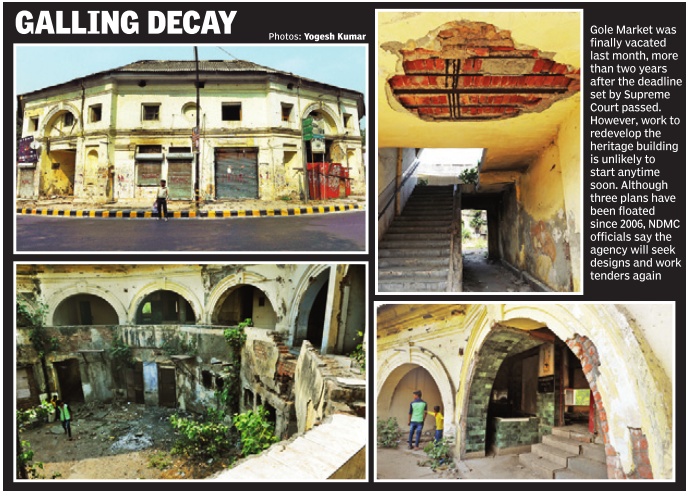
Greater Kailash I
Revival of abused Lodi-era monument
The Times of India, Jun 01 2015
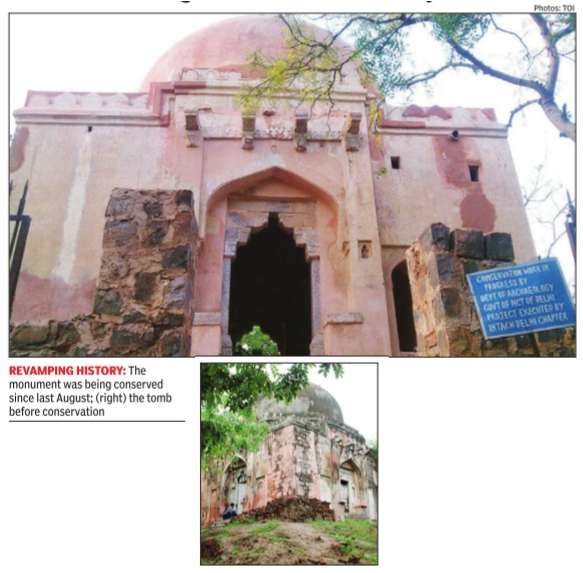
Richi Verma
Abused Lodi-era tomb gets new life
For decades, this Lodi-era monument served as a library , a venue for community gatherings and a makeshift living area for squatters. However, this unknown tomb located in a public park in upscale Greater Kailash I area has just been revived. The monument, which had fallen victim to neglect, deteriorated with time, and saw rapid encroachment through the years, was hand-picked for an elaborate conservation and protection programme by the India National Trust for Art and Cultural Heritage (Intach) in a collaborative project with the Delhi government's archaeology department.
The project started last August, and since then, a considerable difference can be seen in the historic building. Though located inside a central park near Nblock market, the monument has rarely seen any visitors.
“It is on a raised mound and clearly visible from the main road. Towards its south, there are a series of steps made at a later date. In the immediate surrounding or in the park, there are no other historic monuments. However, the Lodi-period monuments in the Zamrudpur village are in the vicinity , said officials.
Through the decades, a num ber of alterations were made to its original facade. “Cement plaster was used extensively and even a room was constructed near the dome which was razed. It took a lot of time and effort to remove the alterations without harming the structure.We managed to get hold of archival pictures from the 1950s which showed us how the building used to look like originally. This helped us recreate missing elements as well, said Intach officials.
Portions of the mehrab were missing and the niches were buried under the cement plaster. The red and blue hand running through the interiors were hardly visible and had to undergo chemical cleaning. “The medallions were defaced and all decorative elements suffered immense damage and decay from years of neglect, said an official.
The tomb stands on a mound about a height of 3.5m from the ground level around. “There is no mention of any enclosure wall by Zafar Hasan; however, there are some remains of a stone wall to the east of the tomb, which seems like a retaining wall. Further investigation need to be done in this regard, reads a description of the monument in the Intach listing.
Architecturally , the tomb has a square plan and has some unique features such as the sand stone brackets supporting the chajja, rectangular openings stone pillars, lintels and brackets, domed ceiling with bands in incised plaster etc which attributes the tomb to belong to either Tughlaq or early Lodi period.
“The tomb has been put to various uses in the past. It is located in a modern locality of Delhi, inside the DDA park and is prominently visible from the main road. Now that, the tomb is secured by the government, it will be conserved and restored appropriately by rectifying all wrong repair works done and by recreating lost features. The surrounding must also be developed after procuring land from the DDA.Once conserved and developed, the residents are definitely going to appreciate this unique historic structure in their locality and take pride in it, said an official.
Gole Market
Mayank Manohar|Has NDMC all but abandoned Gole Market?|Jul 11 2017 : The Times of India (Delhi)
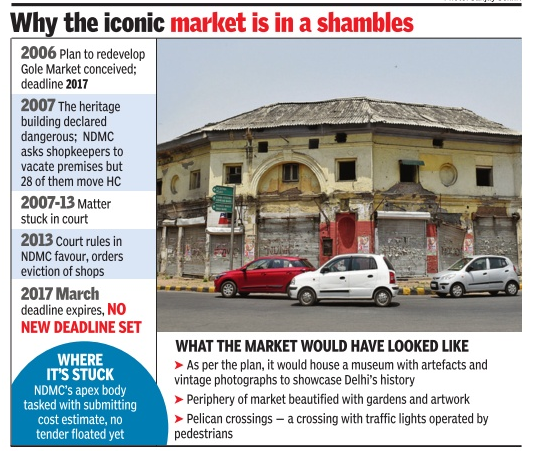
From The Times of India